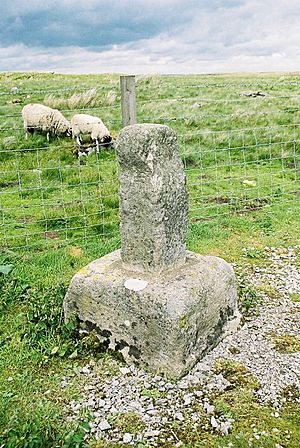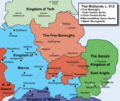Eric Bloodaxe facts for kids
Quick facts for kids Eric Bloodaxe |
|
|---|---|

Coin of Eric Bloodaxe, which reads "ERIC REX"
|
|
| King of Norway | |
| Reign | 931–933 |
| Predecessor | Harald I |
| Successor | Haakon I |
| King of Northumbria | |
| Reign |
|
| Predecessor | |
| Successor | |
| Died | c.954 Battle at Steinmor [Stainmore], Pennine hills, Cumbrian border region, Britain |
| Spouse | Gunnhild, Mother of Kings |
| Issue |
|
| Dynasty | Fairhair dynasty |
| Father | Harald Fairhair |
| Mother | Ragnhild the Mighty |
| Religion | Norse paganism |
Eric Haraldsson (also known as Eric Bloodaxe) was a famous Norwegian king during the Viking Age. He earned his nickname "Bloodaxe" because he was known for being very violent. He ruled as King of Norway from 932 to 934. Later, he became King of Northumbria in England two times: from 947 to 948, and again from 952 to 954.
Who was Eric Bloodaxe?
Eric Haraldsson was a powerful Viking leader. He was known for his fierce fighting skills. His nickname, "Bloodaxe," likely came from his violent actions. Some stories say he got it because he killed his own half-brothers. This was to make sure he was the only ruler in Norway. Other tales suggest it was because he was a brutal Viking raider. He was also called "Brother-Slayer" for similar reasons.
Eric's Family Background
Who was Eric's father?
Eric was the son of Harald Fairhair, a famous Norwegian king. Harald Fairhair was known for uniting Norway. This connection made Eric part of a powerful royal family. Some old poems also link Eric to Harald's family. These poems mention a ruler in York who was from Harald's family line.
Did Eric have brothers?
Yes, Eric had many brothers. Some old texts mention that Eric died with his son, Harékr, and his brother, Ragnvald. These names also appear in other sagas. This suggests he fought alongside his family members.
Eric's mother and half-brothers
According to some stories, Eric's mother was Ragnhildr. She was the daughter of a king from Jutland, Denmark. King Harald Fairhair had many sons with different women. Eric was one of the oldest. His younger half-brother, Haakon, later became king after Eric. The sagas describe Harald as a king with many wives and children.
Eric's Early Life
When Eric was young, he was fostered by a nobleman named Thórir. This was a common practice for Viking children. Stories say Eric started his Viking adventures at just twelve years old. He was very brave and strong. He spent years raiding different lands. He attacked coasts in the Baltic Sea, Denmark, and Germany. He also raided Scotland, Wales, Ireland, and France. He even sailed far north to Lappland and Bjarmaland (in modern Russia). One story says he sailed up the Dvina River. He then attacked a trading port called Permina.
Eric's Marriage
Eric married a woman named Gunnhild. She was a very famous figure in Viking stories. Some early writings suggest Eric's wife might have been from Britain or Scotland. However, later sagas all agree that Gunnhild was his main partner. She is often described as a powerful and sometimes cruel woman. Her father was named Ozur. Gunnhild is mentioned in several old poems.
Eric as King of Norway
The sagas tell us that King Harald Fairhair wanted Eric to be his successor. Harald had given different parts of Norway to his sons to rule. Eric was his favorite. Eric was known for being very harsh and cruel. He even killed some of his half-brothers. This was to make sure he had full control over Norway.
When Harald died, Eric became king. He continued to fight his brothers. But Eric's rule was not popular. The Norwegian nobles did not like his harsh ways. At this time, Eric's younger half-brother, Haakon, returned to Norway. Haakon had been raised in England by King Æthelstan. The nobles quickly supported Haakon as their new king. Eric was forced to flee Norway and went to Britain.
It is hard to know the exact dates of Eric's rule in Norway. This is because the old stories have confusing timelines. There are no clear records from that time about his reign.
Eric and the Orkney Islands
After leaving Norway, Eric went to Britain. The sagas tell different stories about how he got there. Some say he went straight to England. Others say he first went to Denmark.
Later sagas say Eric spent time in the jarldom of Orkney. This was a Viking base that his father had taken over. Eric made alliances with the local earls there. He used Orkney as a base for his raids. From Orkney, he launched attacks on Ireland, the Hebrides, Scotland, and England. To strengthen his alliances, Eric married his daughter, Ragnhild, to Arnfinn. Arnfinn was the son of an Orkney earl.
Eric as King of Northumbria
Eric became king in Northumbria, a region in northern England. This is where he appears more clearly in historical records. Northumbria was a place often fought over. English kings and Viking rulers from Dublin both wanted control of it.
Northumbria's History Before Eric
King Æthelstan's Rule
In 927, King Æthelstan of England took control of Northumbria. He won a big battle in 937. This victory helped him control all of Britain.
King Edmund and the Olafs
Æthelstan died in 939. His successor, King Edmund, was young. He struggled to keep Northumbria. Two Viking rulers from Ireland, both named Olaf, took over York. The Northumbrians chose Olaf as their king. Edmund fought back and regained some areas. He even made peace with Olaf for a time. But in 944, Edmund drove both Viking rulers out of Northumbria.
Eric's First Reign (947–948)
When King Eadred became king in 946, Northumbria was still unstable. In 947, the Northumbrians broke their promises to Eadred. They chose Eric as their king in 948. King Eadred was angry. He attacked Northumbria and burned the Ripon minster. Even though Eadred's army suffered losses, he forced the Northumbrians to abandon Eric. They paid Eadred money and Eric was removed from power.
Eric's Second Reign (952–954)
After Eric was removed, Olaf (Amlaíb Cuarán) returned and became king again in 949. But in 952, the Northumbrians drove Olaf out. They accepted Eric, son of Harald, as their king once more. Eric's second reign was also short. In 954, the Northumbrians expelled him again.
Coins from Eric's Rule
Coins found in York confirm Eric's rule in Northumbria. These coins have his name on them. They show a sword symbol. The same moneyers (coin makers) who worked for Olaf also made coins for Eric. This suggests they were minted during his time as king.
Eric's Death
The historical records do not fully explain Eric's death. But they suggest it was linked to Northumbrian politics. One account says Eric was driven out and killed by a man named Maccus. This happened in a lonely place called Stainmore. He was betrayed by Earl Osulf. Eric's son, Haeric, and his brother, Ragnald, also died with him.
Stainmore is in the Pennine hills. It is on an old Roman road. Eric might have been trying to reach Strathclyde or the Hebrides. Earl Osulf of Bamburgh benefited from Eric's death. He became the earl of Northumbria. The identity of Maccus, Eric's killer, is not fully clear. He might have been from a Norse-Gaelic family.
Some sagas say Eric died in a big battle in England. Others claim he died on a raid in Spain. However, most historians believe Eric was assassinated. It seems Eric was expelled and heading northwest. Osulf, who was in charge of that area, had Maccus kill him. It is unclear if Maccus ambushed Eric or betrayed him while acting as an escort.
The Poem Eiríksmál
The Fagrskinna saga includes a poem called Eiríksmál ("Lay of Eric"). This poem was written to honor Eric after his death. It is believed his widow, Gunnhild, ordered it.
The poem describes Eric's arrival in Valhöll, the hall of Odin. He is welcomed by Odin and other heroes. Odin had been waiting for Eric because he had "reddened many lands with his sword." The poem suggests Eric was a great warrior.
Even though the poem is about pagan gods, some sagas suggest Eric might have become a Christian. If he wanted to be accepted as king in Northumbria, he would likely have needed to accept Christianity.
The Rey Cross
Today, a stone cross called the Rey Cross stands in Stainmore. It is mostly a stump now. It is believed to be an Anglo-Scandinavian cross from the 10th century. It might have been a boundary marker between Cumbria and Northumbria. Some people have wondered if it was a memorial for Eric. However, there is no strong evidence to support this idea.
Eric's Reputation in Sagas

In the Norse sagas, Eric is shown as a larger-than-life Viking hero. He was powerful and violent. He had many short-term successes. But his harsh rule made him unpopular. The Heimskringla saga describes Eric as handsome and strong. It says he was a great warrior. But it also calls him cruel and gruff. Some sagas blame his wife, Gunnhild, for his cruel actions.
Conflict with Egill Skallagrimsson
The Egils saga tells a long story about Eric and his conflict with Egill Skallagrimsson. Egill was a famous Icelandic Viking and poet. Queen Gunnhild hated Egill. She wanted revenge because Egill had killed one of the king's men. She ordered her brothers to kill Egill. But Egill killed them instead. This made Gunnhild even angrier.
After Eric became king, he declared Egill an outlaw. Egill then killed Eric's son, Ragnald. Egill even put a horse's head on a pole and cursed Eric and Gunnhild. This was a serious insult. Gunnhild also put a spell on Egill.
Later, Egill was shipwrecked in England. He came before Eric, who sentenced him to death. But Egill wrote a poem praising Eric during the night. When he recited it, Eric was so impressed that he forgave Egill.
Eric in Modern Culture
- In his poem Briggflatts, Basil Bunting mentions Eric Bloodaxe and his death.
- Poul Anderson wrote Mother of Kings, a book about Queen Gunnhild. It includes Eric and their children.
- Eric appears as a character in the mobile game Fate/Grand Order.
- He is also in Philip José Farmer's Riverworld book series.
- Eric is a character in the Oathsworn series of Viking Age novels by Robert Low.
Images for kids






